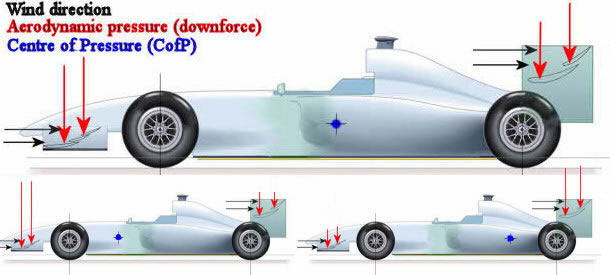Aerodynamic balance or
Centre of Pressure (CofP)

A state of equilibrium between the downforce on the front wheels and the downforce on the rear wheels. Too much pressure at the front causes oversteer, too much at the back understeer.
But to win the races, it is not just wings. You can't just add the wings to get win. The most important thing apart from the wing level which always helps you go around corners is to have the overall balance. In this case you can feel very comfortable in the car.
An f1 cars downforce is produced largely by the front wing, rear wing and the floor. With the front and rear wings being the main tuning elements. By tuning the front and rear downforce you alter the cars Centre of aerodynamic Pressure.
Centre of Pressure (CofP) is the balance of downforce at the front and rear axles. As such it’s analogous to being the aerodynamic equivalent of Longitudinal Centre of Gravity. CofP is also known as aero balance.
Typically the CofP position closely matches that the CofG.
An F1 car is largely limited on corner entry by the rear grip available. In low to mid speed turns the car needs a slight rear bias to the CofP, this prevents the car suffering corner entry oversteer. Where the car wants to spin as it approaches the apex. Too much front wing in these corners will make the car too pointy and hinder laptimes.
In faster turns the front wing can lead the car. The drivers turn in gentler in to fast turns, which creates less lateral acceleration at the rear axle. So it’s rare for the rear to step out on turn-in in to fast corners. Thus, at higher speeds you can have a CofP biased towards neutral or the front.
But better controlling the aerodynamic platform of a car can be a valuable tool in reducing the stress put upon the tires. The centre of aerodynamic pressure is the aerodynamic equivalent of the weight distribution.
When the car is braking, that centre of pressure moves forward.
When the braking is reduced and released, the centre of pressure moves back.
This modern generation of cars with ground effect underbody, deriving so much of its downforce from there, has a centre of pressure quite far back, given that the lowest point of the floor is towards the back, just before the diffuser. With the flat-bottom generation of car, the lowest point of the floor was its leading edge. Consequently, the centre of pressure is trying to move more with these cars as they are braked then unbraked.
This can create problems with the rear tires, as the inconsistent loads upon them cause them to degrade faster. Improving the consistency of the airflow along the floor, and thus making it more robust, would help with reducing the load variation on the rear tires. If the airflow is not adequately controlled, it can be that some of the downforce generated when the car is pointed straight is lost when it is in yaw or when steering lock is applied. This too would tend to overwork the rear tires.






